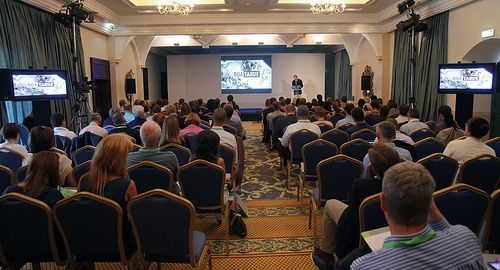Route map
• Introduction to AMEC
• Defining ROI
• Financial v non financial ROI
• Social media
• Outputs to outcomes – introducing the Valid Metrics grids
• Beyond AVE
• Questions and debate…
AMEC – a very brief history
• Founded to represent major media analysis companies
• Informal mission: “to create educated consumers for measurement”
• Initially UK focus
• 2011 > 100 members, 35 countries
• Includes
o Measurement companies
o PR agencies and consultancies
o Academics
• Key activities
o European Summit on Measurement (June)
o London Measurement Conference (November)
o Webinars
o Regional mini-Summits
• Resources
o Knowledge share
o Online college
The Barcelona Principles
1. Importance of goal setting and measurement
2. Measuring the effect on outcomes is preferred to measuring outputs
3. The effect on business results can and should be measured where possible
4. Media measurement requires quantity and quality
5. AVEs are not the value of public relations
6. Social media can and should be measured
7. Transparency and replicability are paramount to sound measurement
Where to start?
• Return is
o Financial
o Revenue
o Avoid cost
o Reduce cost
• Non financial
o Reputation
o Stock/share price
o Employee engagement/productivity
• Investment is
o Financial
o Human
ROI definition
“The … definition of ROI is a ratio of how much profit or cost saving is realised from an activity against its actual cost … often expressed as a percentage.”
“In reality few PR programs can be measured in such a way …” (IPR 2004)
UK industry survey of ROI – 2010
• 2/3rds of PR people use “ROI” term when planning and evaluating communication activity. ROIs related to communication objectives (66.7%) much more widely used than financial ROIs (12.8%)
• Clear difference in ROI practices between consultants/freelances and in-house colleagues. Consultants and freelances (73.1%) offer an ROI formula to clients but only 26.3% of in-house practitioners have one;
• Industry-wide ROI formula: only 35.6% supported the proposition with 64.4% opposed. “No one size fits all”.
ROI – the old model
• Marketing
o Sales
o Responses
o Enquiries
o Costs
• Advertising
o Reach
o Advertising value
o Equivalency (AVE)
• Public Relations
o Placement
o Clips
o Promotion
RETURN ON INVESTMENT
ROI – a new model
• Financial indicators
o Sales
o Responses
o Enquiries
o Costs
• Reputational indicators
o Credibility
o Reputation
o Confidence
o Trust
• Stakeholder expectation
o ROE
RETURN ON INVESTMENT
And then there is a social media…
IMPACT AND ROI
• ROI is a form of impact, but not all impact takes the form of ROI
• ROI is a financial metric. It is tangible. Must take one of three forms:
1. Revenue generated
2. Cost savings
3. Cost avoidance
• Impact is an investment that eventually may, over time, be ‘cashed in’ as ROI. It has both tangible and intangible components.
• A small percentage of social business efforts are designed to achieve true ROI in the short-term
• They are an investment, creating impact/value that accumulates over time
A hypothetical example
• Assumptions:
– 25% of video views mitigated call center calls
– 50% of tweets resolved in-channel (crowd-source or via response), 50% to call center
– Average call center time-to-resolution = 2 minutes
– Average time spent per video view = 2 min
Non-financial Indicators – the Philips model
• Employee retention
• Calls to customer service line
• Loyalty behavior / Scope of purchases
• Recommending brand
• Repeat purchases
• Customer retention
• Number of influencers advocating your message
• Online engagement with consumer base
• Community support for company initiatives
• Customer satisfaction
• Message recall
The alternative modelling approach
• How much share/impact do specific communication measures have against company performance?
• What is the optimum communication budget (ROI) in order to achieve the company’s target?
• What media mix has the biggest effect on brand awareness?
• Which products out of the portfolio are the best drivers?
• Should communication activities be planned in parallel to competitors or in clear space?
• Which communication strategy is most successful?
Replacing AVEs
• To provide a dollar/euro/yen or other financial denomination for PR results, try using:
– Total value of sales/sales leads/revenue generated by PR activities
– PR activities’ contribution to sales/sales leads/revenue (often calculated via marketing mix analysis)
– Cost savings due to PR activities (e.g. reduced customer complaints, etc.)
– Increased target market size due to expanded mindshare
– Increased or decreased market capitalization
The Lisbon Agenda
200 delegates at the AMEC 2011 Summit agreed 4 key priorities for action
1. How to measure the return on investment (ROI) of public relations (89%)
2. Create and adopt global standards for social media measurement (83%)
3. Measurement of PR campaigns and programmes needs to become an intrinsic part of the PR toolkit (73%)
4. Institute a client education program such that clients insist on measurement of outputs, outcomes and business results from PR programs (61%)
Reflecting views of clients, PR agencies, measurement companies
Kaynak
Mike Daniels
ICCO 2011 Zirvesi
http://iccosummit.org/static.php?content_id=12









